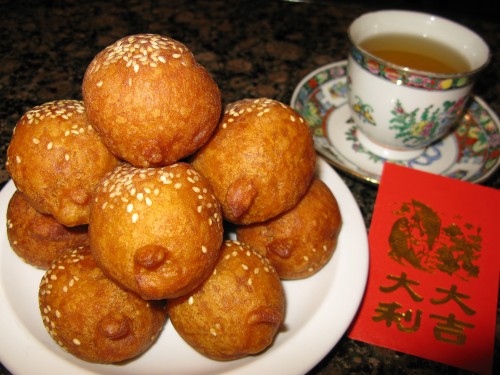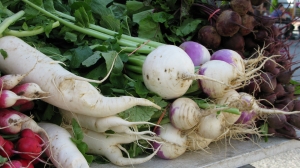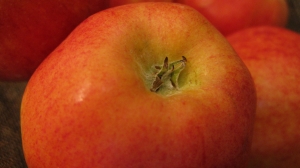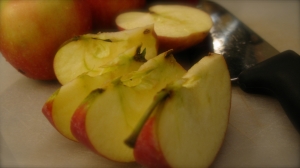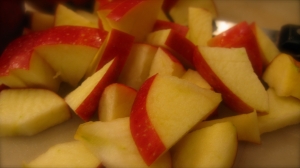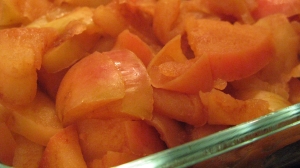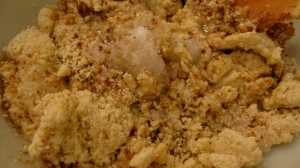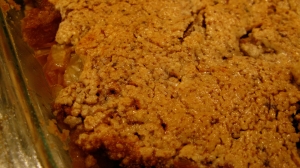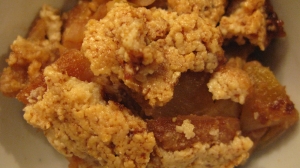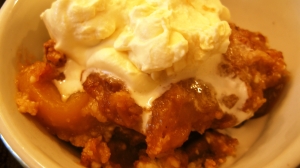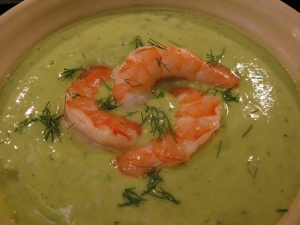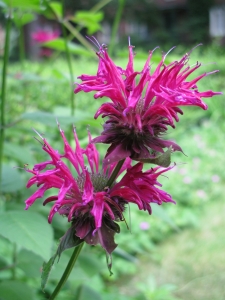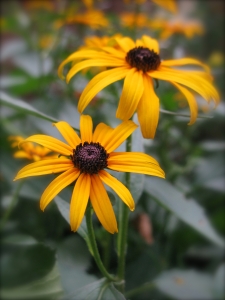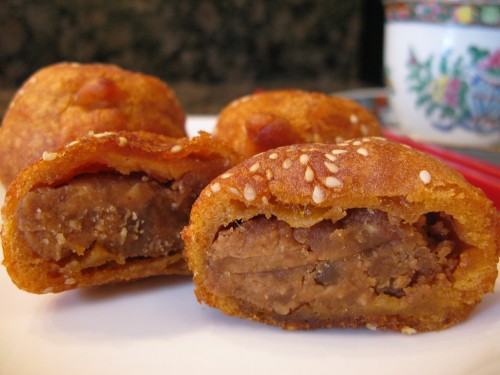
Mom’s recipe changed through the years. When were children, the filling was crushed peanuts, sweetened shredded coconut, Chinese dried dates, and pork fat. Our job was to crush the peanuts with a glass bottle that served as our rolling pin. Eventually pork fat was given up for a healthier filling—freshly ground Valencia peanut butter and lotus seed paste.
The outer layer, made of glutinous rice flour and Chinese brown sugar, varied with the addition of sweet potato or no sweet potato depending upon its availability. I use as much sweet potato as the dough will allow me to increase the nutrition and fiber to these sweet golden jewels. When these are made right, the outer layer is crispy and thin on the outside and chewy on the inside. The filling is creamy and flavors the neutral glutinous rice flour exterior. If crunchy peanut butter is used, there is an added surprise crunch as you chew.
Tee Doys (Sesame Balls)
Makes about 39 plus (extra good when shared with friends and neighbors)
1/4 Cup of raw sesame seeds
2/3 Cup of filtered water
1 sweet potato about 1 3/4 lb. (peel and cut into cubes)
1 lb. of Chinese brown sugar or substitute with coconut crystals
1 lb. of freshly ground organic Valencia peanut butter
1 lb. of lotus seed paste
1/2 Cup of cold filtered water
2/3 Cup of Thai glutinous rice flour
1 box of Mochiko Sweet Rice Flour
32 ounces of high heat cooking oil (sunflower oil)
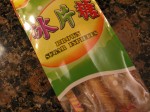
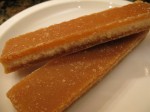
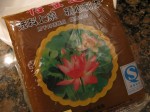
The Chinese brown sugar and lotus seed paste can be purchased in Chinese grocery stores. The brown sugar may come in blocks of 10 pieces or 5 piece packs. Use a total of one pound. If you use a large sweet potato, use less sugar.
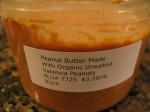
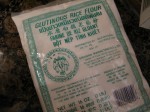
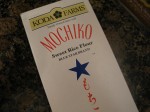
The Thai Glutinous Rice Flour and Mochiko Sweet Rice Flour can also be purchased at Chinese grocery stores. The Thai Glutinous Rice Flour is more finely ground.
Utensils:
measuring cup
medium bowl for peanut butter-lotus seed paste
small bowl for sesame seeds
medium bowl for gooey Thai glutinous flour-water mixture
medium pot
wok
rack to hold wok in place
small rack to drain tee doys (sesame balls)
1 pair of wooden chopsticks or a wooden spoon with a flat edge
1 teaspoon to spoon peanut butter-lotus seed filling into each tee doy
1 fork to mash sweet potatoes
1. Toast sesame seeds in medium pot. Place in small bowl. Set aside.
2. Peel and cube sweet potato.
3. Place cubed sweet potato and 2/3 cup water in medium pot and bring to boil. Lower flame. Cook until soft.
4. Mash sweet potato with fork.
5. Break Chinese brown sugar into smaller pieces and add to mashed sweet potato. Cover.
6. Cook mixture until all the sugar is dissolved over a low flame. If more water is needed, add a small amount. Keep an eye on the mixture. Stir occasionally with wooden chopsticks or wooden spoon. Don’t let mixture overflow or burn.
7. In a medium bowl, add 1/2 cup of cold water to 2/3 cup of Thai glutinous rice flour. Mix. It will look gooey.
8. With wooden chopsticks or a wooden spoon, stir small amounts of the gooey glutinous rice mixture into the pot of sugar-sweet potato. Continue adding and stirring. The mixture will get stiff and turn darker. As you stir, it will cook and start to pull away from the sides of the pot as you stir.
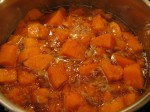
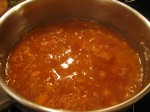
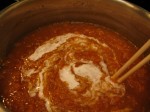
9. Coat a cookie sheet or marble slab with Mockiko Sweet Rice Flour. Reserve some flour for coating hands and dough.
10. Place a half box of Mochiko flour on to cookie sheet or marble slab.
11. Make a well in the pile of flour and pour a small amount of the hot sweet potato-sugar-glutinous rice flour mixture into the well. Start kneading the mixture. Continue adding more flour a bit at a time as you knead until the dough is no longer sticky—almost the entire box. Be careful with the hot mixture!
12. Break about 1 1/2 inches of dough off and roll into a ball.
13. Press ball into the reserved Mochiko Sweet Rice Flour.
14. Press the reverse side of ball into sesame seeds.
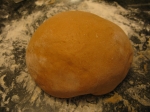
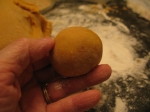
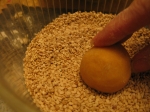
15. Over the dish of sesame seeds, start to make a bowl-shape. Push down into the side of dough with flour using your thumbs. Turn the bowl-shape as you press the sides of the bowl between your thumbs and index fingers to make the wall of the bowl thinner.
16. Fill the bowl-shape with the peanut butter-lotus seed filling.

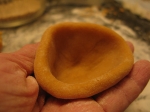
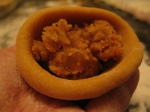
17. Using your thumb and index finger bring about 1/16th of an inch together on the edge of the bowl. Repeat this around the entire edge until the opening is smaller.
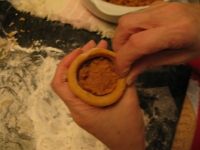
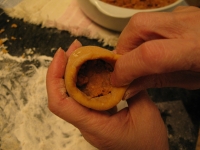
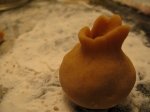
18. Pinch opening closed.
19. Flatten long piece of dough.
20. Fold piece of dough back.

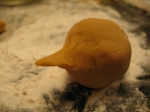

21. Heat oil until hot but not smoking. Keep the flame low to low-medium. When you smell the oil, it is hot enough to start cooking the tee doys.
22. Place one tee doy into the hot oil. Gently move it around in the hot oil with your wooden chopsticks.
23. When the tee doy turns slightly golden, place another tee doy into the oil. Gently move the tee doys around and keep them separated with your chopsticks. Continue adding a new tee doy as the previous tee doy turns slightly golden. I usually have 3 tee doys of different degrees of doneness in the wok.
24. When the tee doy is golden, remove it from the oil and place on the draining rack on the wok. If you don’t have a draining rack, use a dish with paper towels.
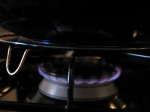
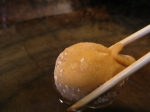
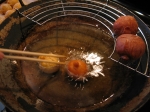
25. After they’re drained and cooled, they can be served with your favorite beverage or eaten as a snack.
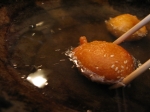
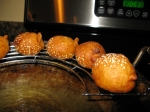
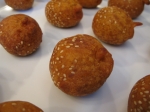
There’s nothing like biting into a freshly cooked tee doy. The dough is crispy on the outside and soft on the inside. They’re even more delicious the next day. The sweet potato and rice flour flavors are more pronounced.
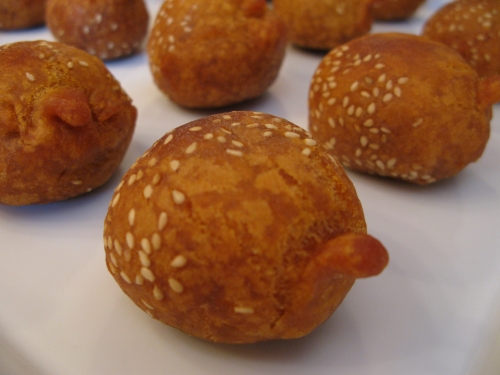
Modifications and Suggestions:
Tee doys are served during the Chinese New Year as a holiday treat, usually once a year. As with serving any fried foods, I try to maintain the alkaline-acid balance, the proper omega 6–omega 3 ratios, and boost the antioxidant levels by adding other nutritious ingredients and foods to the rest of the day’s meals.
1. Only use high-heat oils sunflower or safflower or avocado oil (a monounsaturated omega-9 fatty acid). Don’t use low or medium heat oils. They may become carcinogenic when heated too high or to its smoking point.
Since omega 6 oils are very unstable, don’t reuse the oil.
I’ve been thinking of trying coconut oil to cook my tee doys next year. I understand that coconut oil can be heated to 350º. I’ll heat the oil close to 350º and see how well a tee doy cooks.
If you have fried in coconut oil, please let me know what you think.
2. Sunflower and safflower, canola, peanut, soybean oils are all polyunsaturated oils with no omega 3’s or a very low omega 3 to omega 6 ratio; therefore, I balance these treats with some omega 3’s—fish or krill oil, eat some fish high in omega 3 (salmon or cod) during a meal, or serve omega 3 eggs during breakfast.
3. Eat or drink some extra antioxidants—blueberries, dark chocolate, prunes, oregano, or green tea.
4. Balance these fried treats (acid) with an alkaline soup or eat a seaweed salad during the day.
Copyright 2009-2018 by Nurturing Wisdom

